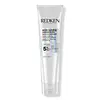What's inside
What's inside
 Key Ingredients
Key Ingredients

No key ingredients
 Benefits
Benefits

 Concerns
Concerns

 Ingredients Side-by-side
Ingredients Side-by-side

Water
Skin ConditioningCyclopentasiloxane
EmollientDimethiconol
EmollientCetearyl Alcohol
EmollientBehentrimonium Methosulfate
Dicetyldimonium Chloride
EmulsifyingCyclomethicone
EmollientDipropylene Glycol
HumectantPolysilicone-29
Ethylhexyl Cocoate
EmollientHydrogenated Vegetable Oil
EmollientIsopropyl Myristate
EmollientOctyldodecanol
EmollientCetrimonium Chloride
AntimicrobialGossypium Herbaceum Seed Oil
Skin ConditioningPrunus Amygdalus Dulcis Oil
Skin ConditioningZea Mays Oil
EmulsifyingHelianthus Annuus Seed Oil
EmollientTriticum Vulgare Germ Oil
EmollientPersea Gratissima Oil
Skin ConditioningLecithin
EmollientHydrogenated Polyisobutene
EmollientGlyceryl Linoleate
EmollientGlyceryl Linolenate
EmollientTocopheryl Acetate
AntioxidantParfum
MaskingMyrica Cerifera Fruit Wax
EmollientXylityl Sesquicaprylate
AntimicrobialHydrolyzed Wheat Protein
Skin ConditioningMethicone
EmollientPolyquaternium-10
Carbocysteine
AntiseborrhoeicMauritia Flexuosa Fruit Oil
Skin ConditioningBis-Cetearyl Amodimethicone
Water, Cyclopentasiloxane, Dimethiconol, Cetearyl Alcohol, Behentrimonium Methosulfate, Dicetyldimonium Chloride, Cyclomethicone, Dipropylene Glycol, Polysilicone-29, Ethylhexyl Cocoate, Hydrogenated Vegetable Oil, Isopropyl Myristate, Octyldodecanol, Cetrimonium Chloride, Gossypium Herbaceum Seed Oil, Prunus Amygdalus Dulcis Oil, Zea Mays Oil, Helianthus Annuus Seed Oil, Triticum Vulgare Germ Oil, Persea Gratissima Oil, Lecithin, Hydrogenated Polyisobutene, Glyceryl Linoleate, Glyceryl Linolenate, Tocopheryl Acetate, Parfum, Myrica Cerifera Fruit Wax, Xylityl Sesquicaprylate, Hydrolyzed Wheat Protein, Methicone, Polyquaternium-10, Carbocysteine, Mauritia Flexuosa Fruit Oil, Bis-Cetearyl Amodimethicone
Water
Skin ConditioningDimethicone
EmollientCetearyl Alcohol
EmollientAmodimethicone
Phenoxyethanol
PreservativePolyquaternium-37
Dimethiconol
EmollientParfum
MaskingPropylene Glycol Dicaprylate/Dicaprate
EmollientTrideceth-5
EmulsifyingSteareth-20
CleansingCetyl Hydroxyethylcellulose
Emulsion StabilisingGlycerin
HumectantCitric Acid
BufferingLimonene
PerfumingPPG-1 Trideceth-6
Skin ConditioningTrideceth-10
CleansingSodium Hydroxide
BufferingChlorhexidine Digluconate
AntimicrobialSorbitan Oleate
EmulsifyingAcetic Acid
BufferingLinalool
PerfumingCitronellol
PerfumingCitral
PerfumingEugenol
PerfumingWater, Dimethicone, Cetearyl Alcohol, Amodimethicone, Phenoxyethanol, Polyquaternium-37, Dimethiconol, Parfum, Propylene Glycol Dicaprylate/Dicaprate, Trideceth-5, Steareth-20, Cetyl Hydroxyethylcellulose, Glycerin, Citric Acid, Limonene, PPG-1 Trideceth-6, Trideceth-10, Sodium Hydroxide, Chlorhexidine Digluconate, Sorbitan Oleate, Acetic Acid, Linalool, Citronellol, Citral, Eugenol
 Reviews
Reviews

Alternatives
Ingredients Explained
These ingredients are found in both products.
Ingredients higher up in an ingredient list are typically present in a larger amount.
Cetearyl alcohol is a mixture of two fatty alcohols: cetyl alcohol and stearyl alcohol. It is mainly used as an emulsifier. Emulsifiers help prevent the separation of oils and products. Due to its composition, it can also be used to thicken a product or help create foam.
Cetearyl alcohol is an emollient. Emollients help soothe and hydrate the skin by trapping moisture.
Studies show Cetearyl alcohol is non-toxic and non-irritating. The FDA allows products labeled "alcohol-free" to have fatty alcohols.
This ingredient is usually derived from plant oils such as palm, vegetable, or coconut oils. There is debate on whether this ingredient will cause acne.
Due to the fatty acid base, this ingredient may not be Malassezia folliculitis safe.
Learn more about Cetearyl AlcoholDimethiconol is a silicone that resembles the popular dimethicone. Like other silicones, it is an emollient. Emollients create a thin film on skin to prevent moisture from escaping.
This ingredient helps to create a silky texture and improve spreadability. Due to its high molecular weight and thickness, it is often combined with cyclopentasiloxane.
Parfum is a catch-all term for an ingredient or more that is used to give a scent to products.
Also called "fragrance", this ingredient can be a blend of hundreds of chemicals or plant oils. This means every product with "fragrance" or "parfum" in the ingredients list is a different mixture.
For instance, Habanolide is a proprietary trade name for a specific aroma chemical. When used as a fragrance ingredient in cosmetics, most aroma chemicals fall under the broad labeling category of “FRAGRANCE” or “PARFUM” according to EU and US regulations.
The term 'parfum' or 'fragrance' is not regulated in many countries. In many cases, it is up to the brand to define this term.
For instance, many brands choose to label themselves as "fragrance-free" because they are not using synthetic fragrances. However, their products may still contain ingredients such as essential oils that are considered a fragrance by INCI standards.
One example is Calendula flower extract. Calendula is an essential oil that still imparts a scent or 'fragrance'.
Depending on the blend, the ingredients in the mixture can cause allergies and sensitivities on the skin. Some ingredients that are known EU allergens include linalool and citronellol.
Parfum can also be used to mask or cover an unpleasant scent.
The bottom line is: not all fragrances/parfum/ingredients are created equally. If you are worried about fragrances, we recommend taking a closer look at an ingredient. And of course, we always recommend speaking with a professional.
Learn more about ParfumWater. It's the most common cosmetic ingredient of all. You'll usually see it at the top of ingredient lists, meaning that it makes up the largest part of the product.
So why is it so popular? Water most often acts as a solvent - this means that it helps dissolve other ingredients into the formulation.
You'll also recognize water as that liquid we all need to stay alive. If you see this, drink a glass of water. Stay hydrated!
Learn more about Water